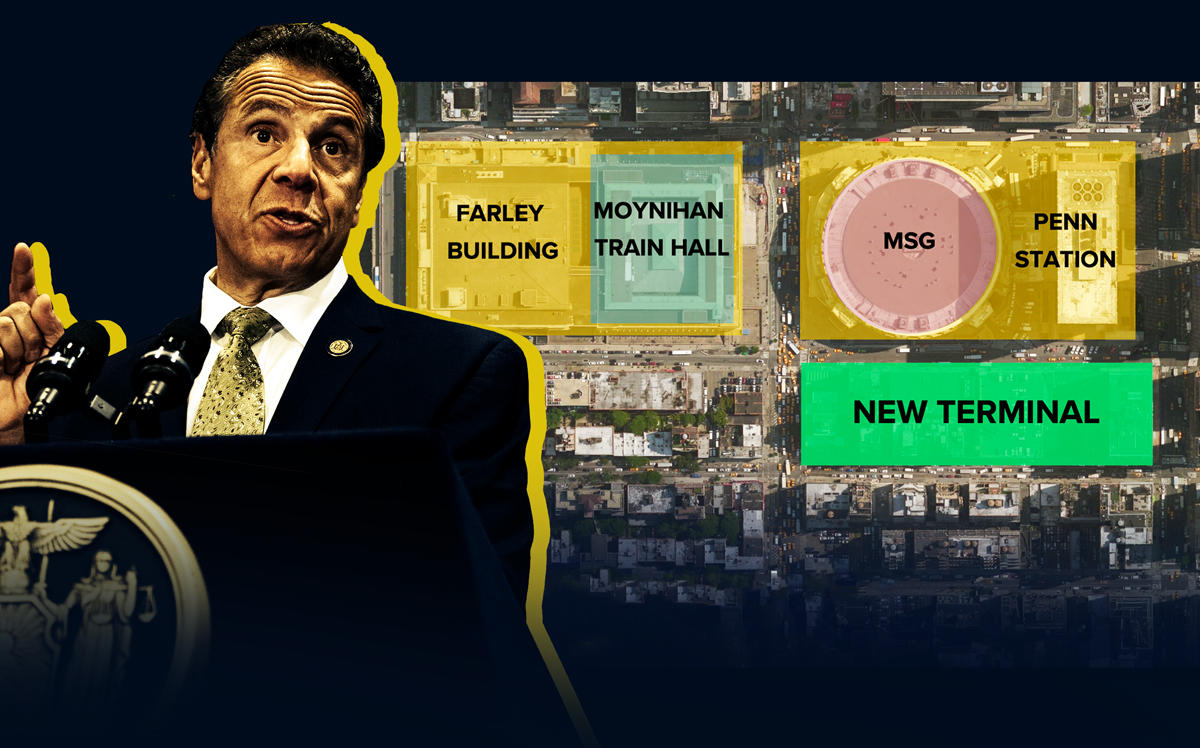Trending
Cuomo plans to acquire private real estate to expand Penn Station
Governor’s sights set on megablock south of transit hub

Gov. Andrew Cuomo unveiled a plan Monday to acquire a full city block south of Penn Station to build another terminal and increase capacity at the rail hub. And while the plan has been in the works for years, the governor’s announcement was news to some property owners.
Several owners on the block between Seventh and Eighth avenues between West 30th and West 31st streets told The Real Deal that they hadn’t heard from the governor’s office about acquiring their properties.
“We haven’t heard anything as yet,” said a representative for the Riese Organization, the large restaurant operator and landlord that owns a two-story building at the corner of West 31st Street and Eighth Avenue.
The block includes properties held by major landlords. The Feil Organization owns the 18-story Seven Penn Plaza building that fronts the entire western side of Seventh Avenue between West 31st and West 30th streets. Gordon Property Group owns the Meyers Parking Garage at 218 West 31st Street right across from Madison Square Garden.
A representative for the Feil Organization declined to comment. The Gordon Property Group did not immediately respond to requests for comment.
In all, there are 51 separate properties on the block, including a residential condominium building on Eighth Avenue with 29 condo units. Other owners include the Archdiocese of New York and Amtrak.
The governor did not mention using eminent domain to acquire the land, but his administration has allowed for that possibility in the past. A statement from Empire State Development suggests the administration views condemning the land as a last resort: “As the governor said today, we are committed to working with every property owner and the broader community throughout this process — and we will work expeditiously to move this transformative project forward.”
Cuomo did not include a price tag for the project, but said it could be paid in part by value capture — using the increased property taxes generated by the undertaking — and earmarking some tax revenue through payments in lieu of taxes, better known as PILOTs. The plan will “create opportunities for redevelopment on the blocks surrounding Penn Station, setting the stage to transform antiquated and underutilized buildings into a new economic engine for New York,” a press release from the governor stated. A previous plan to do that fell apart when the financial crisis struck.
The No. 7 train extension to Hudson Yards was funded by value capture, but the method is rarely used in New York.
During a presentation Monday at the Association for a Better New York, Cuomo said the only way to get more tracks at Penn Station was to increase the station’s footprint.
“We’ve analyzed this and we believe the best alternative is to expand by acquiring the block south of Penn Station,” he said. Acquiring the block would allow Penn to add at least eight more tracks on top of the current 21 tracks, according to Cuomo.
Cuomo’s plan doesn’t include an alternative long favored by many transit advocates: making Penn a station for through-running trains — rather a terminus where trains need time and space to stop and reverse course. That would allow trains to run from New Jersey to Queens and Long Island in both directions, and might not require an expensive land acquisition by the state.
The Regional Plan Association has recommended making Penn a through station, an approach that major rail systems elsewhere in the world have taken, but the group’s president, Thomas Wright, commended Cuomo’s proposal Monday as a “great step for the future prosperity of the entire metropolitan region.”
A spokeswoman for the governor noted that the new plan does not preclude through-running in the future.
But Cuomo’s plan would make the terminal to the south of Penn Station part of a larger, interconnected “Empire Station Complex” that he said would increase train and track capacity by 40 percent. Much of the proposal was a reiteration of previous pitches to overhaul Penn, though Monday’s announcement seemed to jumpstart a piece of the project previously held up by the stalled $30 billion Gateway project.
In September 2018 Cuomo announced that a broader overhaul of Penn Station — in particular, the southern portion of the station — would depend on the Gateway project getting underway. Gateway includes building a new rail tunnel under the Hudson River, redeveloping the existing tunnel between New Jersey and Penn Station and replacing a bridge over the Hackensack River.
The governor’s latest plan to create a new terminal closely follows the proposal for “Penn South,” though it doesn’t seem to depend on Gateway. In addition to adding eight tracks, the terminal would connect to Penn Station and the new Moynihan Train Hall, which is expected to open later this year in the Farley post office building across Eighth Avenue. The governor indicated that the new terminal would allow part of Penn Station to be closed down and renovated.
Monday’s announcement also comes four years after Cuomo first announced plans for an “Empire Station Complex.” In January 2016, the Cuomo administration rolled out a request for proposals/request for expression of interest to reinvent Penn Station, putting forward five different design options. On Monday, Cuomo repeated some of the concepts pitched in the RFP, including a new entrance to Penn Station at Eighth Avenue. That option would require removing Madison Square Garden’s theater, but not the entire arena, as many transit advocates recommend to enable a full redesign of Penn Station. The City Council in 2013 allowed for that possibility by extending the Garden’s special operating permit for only 10 years.
“The acquisition of the theater would be nice,” Cuomo said. “It’s a question of the economic feasibility of that acquisition.”
Cuomo also announced a plan to turn over the 250,000-square-foot Pier 76 on the Hudson River to the Hudson River Park Trust.
“Right now it’s being used by the NYPD as a tow pound,” he said. “It is the most expensive parking lot on the globe.”
The governor said he will propose in his State of the State address that the police department vacate the pier by the end of the year and turn it over to the park’s trust.
Last week, he vetoed plans to redevelop Hudson River Park Trust’s Pier 40 into commercial office space.




